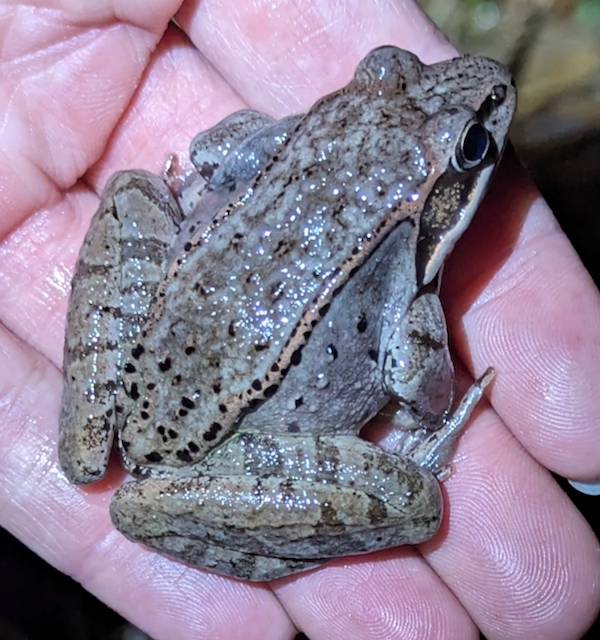
Herp Update: Amphibian Migration Begins, Annual Fundraiser – March 7, 2024
Amphibian Migration Begins
Herpers, Kate Kelly here, filling in for Jim Andrews. With the warm rains on Wednesday of last week, there was some sparse amphibian movement (just a handful of Wood Frogs and a Northern Leopard Frog). But, two days ago, rains began again with temperatures in the 40s, and we received reports of amphibian movement from Proctor and West Rutland (Sarah Allen), New Haven (Matt Gorton), and Salisbury (Monica Przyperhart, Brian Carter, and myself). I checked conditions and amphibian movement on Morgan Road around 6:45 PM. I saw 29 individuals of four species crossing, and subsequent surveyors saw additional individuals. I saw many dead amphibians on my drive back home that evening through Bristol and Monkton.
Last night, with soaking rains occurring during much of the day, we held our first public education and data collection night at Morgan Road in partnership with Otter Creek Audubon Society and Salisbury Conservation Commission. This was the earliest day of the year on which we have held a public education night; the next earliest was on March 22, 2010. On most years movement doesn’t begin in earnest until mid March; a search of our database showed that most survey dates in early March only yielded a few individuals. A survey early in the season on March 1, 2017 was an anomaly as it yielded a total of 113 individuals of 6 species. We hoped to learn more last night about what was moving early in the season after this extraordinarily warm winter.
We had about 40 volunteers help move and count amphibians during the course of our two hours there. Our final count was 196 individuals of seven species (96 Blue-spotted Salamander group, 9 Four-toed Salamanders, 1 Eastern Red-backed Salamander, 13 Spotted Salamanders, 3 Eastern Newts, 73 Wood Frogs, and 1 Spring Peeper). It was interesting to see how few individuals we saw of some species (Red-backed Salamander and Spring Peeper). On the other hand, we saw quite a few Wood Frogs and Blue-spotted Salamanders. Only 7 dates in our database showed more Wood Frogs moving on a single night, and 27 dates reported more Blue-spotteds in one night. Compare that to Spring Peepers, where 73 dates reported more individuals, or Four-toed Salamanders, where 68 dates reported more individuals. This reinforces our knowledge about amphibian migration (e.g. that Wood Frogs and Jefferson/Blue-spotted Salamanders are the first to move). There will be one more public education night this year through Otter Creek Audubon Society; please sign up at this link to be notified about when this night will occur and more details.
We received additional reports of movement from various places in the state last night, including Grand Isle (David Hoag), Poultney (Tom Mauhs-Pugh), and Athens (Lynn Morgan). Keep your eyes out on our next warm rainy night for significant amphibian movement, and please do send your reports our way!
Our Annual Fundraiser Continues
So far, we have received about $19,025 toward our goal of $20,000 in our annual fundraiser. We are just $975 short of our goal. If you have not contributed already, please consider it.
To learn more or to contribute, visit:
https://www.gofundme.com/f/vermont-reptile-amphibian-atlas-fundraiser-24
Photos

The top photo is a salamander in the Blue-spotted Salamander group (a female hybrid), taken by Kate Kelly two nights ago in Salisbury.

The bottom photo is a Wood Frog, taken by Sarah Allen last week in Proctor. To identify this species, look for the dark mask behind the eye, and the white upper lip, which stands out. The dorso-lateral ridges (folds of skin between the back and sides of the animal) can also help differentiate it from Spring Peepers, which do not have these ridges. Males are usually brown in color and slightly smaller. Females are often larger, and this time of year, reddish in color and wide in the abdomen area as they are gravid (full of eggs).

